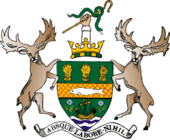Belfast Lough
Belfast Lough is a large, intertidal sea inlet on the east coast of Northern Ireland. At its head is the city and port of Belfast, which sits at the mouth of the River Lagan. The lough opens into the North Channel and connects Belfast to the Irish Sea.
| Belfast Lough Loch Lao (Irish) Bilfawst Loch (Ulster-Scots)[1] | |
|---|---|
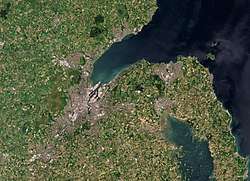 Satellite photo | |
| Location | Northern Ireland |
| Coordinates | 54.691°N 5.785°W |
| Designated | 5 August 1998 |
| Reference no. | 958[2] |
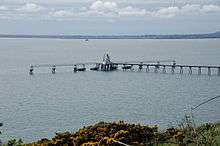
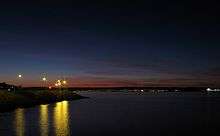
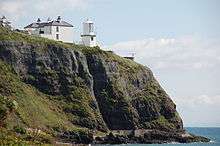
Belfast Lough is a long, wide and deep expanse of water, virtually free of strong tides. The inner part of the lough comprises a series of mudflats and lagoons. The outer lough is restricted to mainly rocky shores with some small sandy bays. The outer boundary of the lough is a line joining Orlock Point and Blackhead.
The main coastal towns are Bangor on the southern shore (County Down) and Carrickfergus on the northern shore (County Antrim). Other coastal settlements include Holywood, Helen's Bay, Greenisland and Whitehead.
Name
Belfast Lough is known in Irish as Loch Lao, which was Anglicised as 'Lough Lee'. Earlier spellings include Loch Laoigh and Loch Laigh. This name means "sea inlet of the calf". The River Lagan, which flows into it, was also historically known as the Lao. It is believed that the lough and river were named after a "bovine goddess". In the 2nd century, the Greek geographer Ptolemy referred to it as the Logia.[3]
Before Belfast grew into a city, the lough was known in English as 'Carrickfergus Bay'. In Ulster-Scots it is called Bilfawst Loch or Craigfergus Loch.[4][5]
History
In 1689 during the War of the Two Kings the Williamite expeditionary force under Marshal Schomberg landed at Bangor, after the lough had been cleared of French shipping by George Rooke. Schomberg occupied the towns of Bangor and Belfast, before successfully laying siege to Carrickfergus. The following year William III also used the lough as a safe anchorage when he arrived in Ireland with reinforcements for Schomberg in the run-up to the victory over the Jacobite army at the Battle of the Boyne.
Wildlife
Nature reserve
The reserve is situated within the Belfast Harbour Estate on the shores of Belfast Lough. The RSPB manages some mudflats in Belfast Lough, together with an area of grassland with a pool and ditch complex near Belfast City Airport, and a lagoon with a hide and viewpoints. The mudflats are important feeding areas for a variety of wading birds and wildfowl. At high tide, flocks of wading birds, such as redshank, oystercatchers and black-tailed godwits, can be seen from the hide and viewing points. The "inner lough" was made an Area of Special Scientific Interest (ASSI) in 1987.[6]
Recorded wildlife includes Crepidula fornicata Lamarck (Slipper Limpet).[7]
Ramsar site
The Belfast Lough Ramsar site (wetlands of international importance designated under the Ramsar Convention), is 432.14 hectares in area, at latitude 54 38 00 N and longitude 05 54 00 W. It was designated a Ramsar site on 5 August 1998. The site contains the inner part of the lough including areas of intertidal foreshore, consisting of mudflats and lagoons, and land, both reclaimed and being reclaimed, which form important feeding/roosting sites for significant numbers of wintering waders and wildfowl. The outer lough is restricted to mainly rocky shores with some small sandy bays and beach-head salt marsh.[8]
In the outer lough, the Ramsar boundary entirely coincides with that of Outer Belfast Lough Area of Special Scientific Interest but within the immediate harbour area the boundary has been redrawn to take into account permitted port related development and landfill which has taken place since the Inner Belfast Lough Area of Special Scientific Interest was declared in 1987. Marine areas below mean low water are not included. The Ramsar boundary entirely coincides with that of the Belfast Lough Special Protection Area. The site qualifies under Criterion 3c of the Ramsar Convention by regularly supporting internationally important numbers of common redshank in winter. The site also regularly supports nationally important numbers of common shelduck, Eurasian oystercatcher, purple sandpiper, dunlin, black-tailed godwit, bar-tailed godwit, Eurasian curlew and ruddy turnstone.[9]
Sailing
Popular for sailing, the lough has three marinas: one at Bangor, one at Carrickfegus and a third located at Titanic Quarter. Belfast docks at the head of a lough contain the famous shipbuilder of the RMS Titanic fame, Harland & Wolff, who are no longer building ships for the foreseeable future and has shed most of its workforce and diversified into repairing and refitting large tankers and oilrigs. Coastguard offices for the lough, although referred to as Belfast Coastguard, are located in the town of Bangor by the marina. In 1912, the RMS Titanic sailed down the lough from Belfast to the Irish Sea for its sea trials.
The lough hosts two Royal Yacht Clubs. One at Cultra just outside Holywood, The Royal North of Ireland Yacht Club, and the Royal Ulster based from Bangor. There are also several other clubs spread around the lough: Ballyholme Yacht Club, Carrickfergus Sailing Club, Cockle Island Boat Club, County Antrim Yacht Club, Donaghadee Sailing Club and Holywood Yacht Club.
For racing sailors, this is a competitor's dream, giving 30 square miles (78 km2) of open water and enough coastline to make short inshore races day-long affairs. Three main arteries serve the lough close to Belfast: the Herdman Channel on the County Antrim coast side; the Victoria Channel, the central and longest route; and the Musgrave Channel on the County Down side.
Railway
The Belfast-Larne railway line skirts the north shore particularly from Carrickfergus and then Downshire to Whitehead and northwards then alongside Larne Lough to Larne Harbour. Trains connect Belfast Great Victoria Street and Belfast Central to Larne Harbour.
The Belfast-Bangor railway line skirts the south shore at Holywood railway station to Marino railway station and Cultra railway station. Trains connect Belfast Great Victoria Street and Belfast Central to Bangor.
Cultra railway station is the home of the Ulster Folk and Transport Museum.
See also
- List of Irish lochs and loughs
- List of Ramsar sites in Northern Ireland
References
- "Blackbird Festival" (PDF). Forbairt Feirste. Archived from the original (PDF) on 25 April 2012. Retrieved 10 April 2017.
- "Belfast Lough". Ramsar Sites Information Service. Retrieved 25 April 2018.
- PlaceNames NI: Belfast Lough
- A Wurd o Walcome Archived 25 April 2012 at the Wayback Machine Blackbird Festival. Retrieved 20 October 2011.
- The Online Scots Dictionary Retrieved 21 August 2012.
- Scott, R. 2004. Wild Belfast on safari in the city. Blackstaff Press. ISBN 0 85640 762 3
- Guy, Claire,G. Reid, N. and Roberts, D. 2013. Ageing of Slipper Limpet (Crepidula fornicate) shells from Belfast Lough. Ir Nat J. 32: 45 – 48
- "Designated and Proposed Ramsar sites in Northern Ireland" (PDF). Joint Nature Conservation Committee. Retrieved 7 July 2008.
- "Belfast Lough Ramsar site". NI Environment Agency. Archived from the original on 5 August 2012. Retrieved 7 July 2008.
External links
| Wikimedia Commons has media related to Belfast Lough. |

